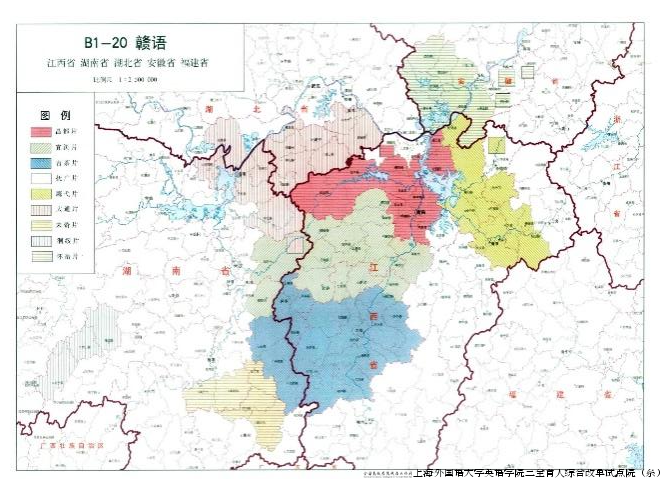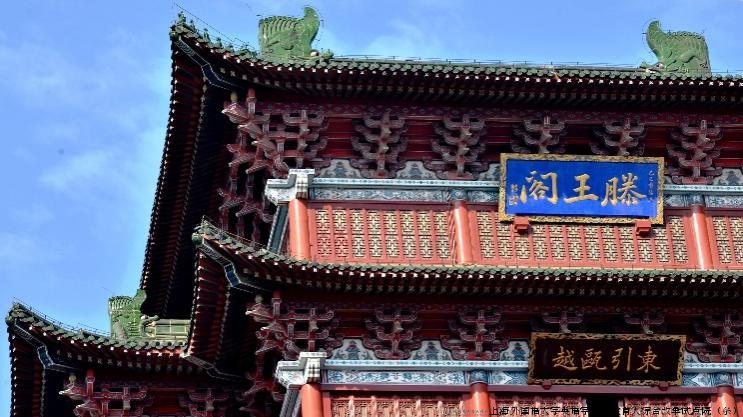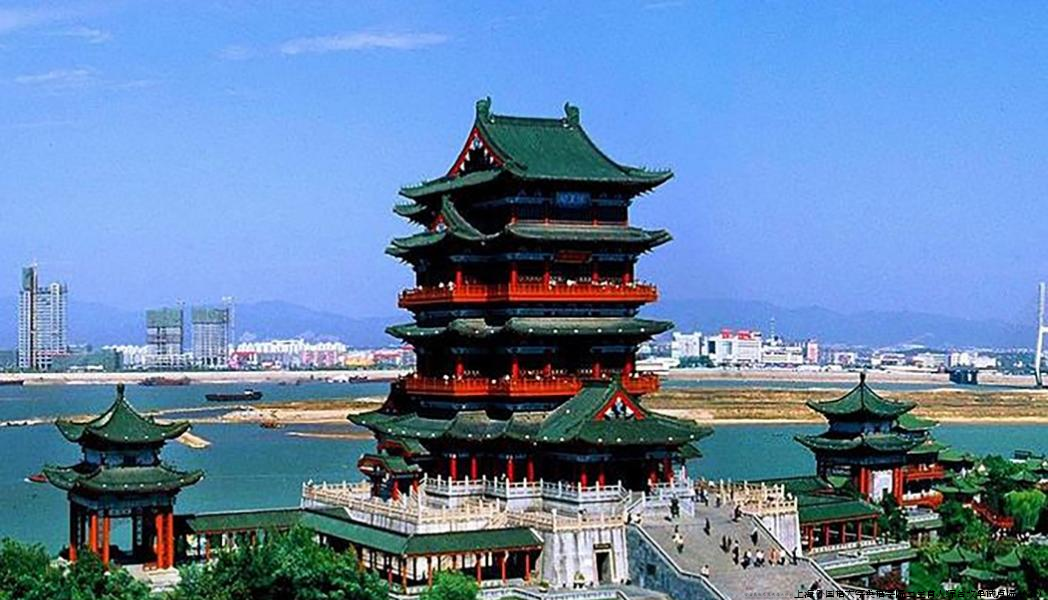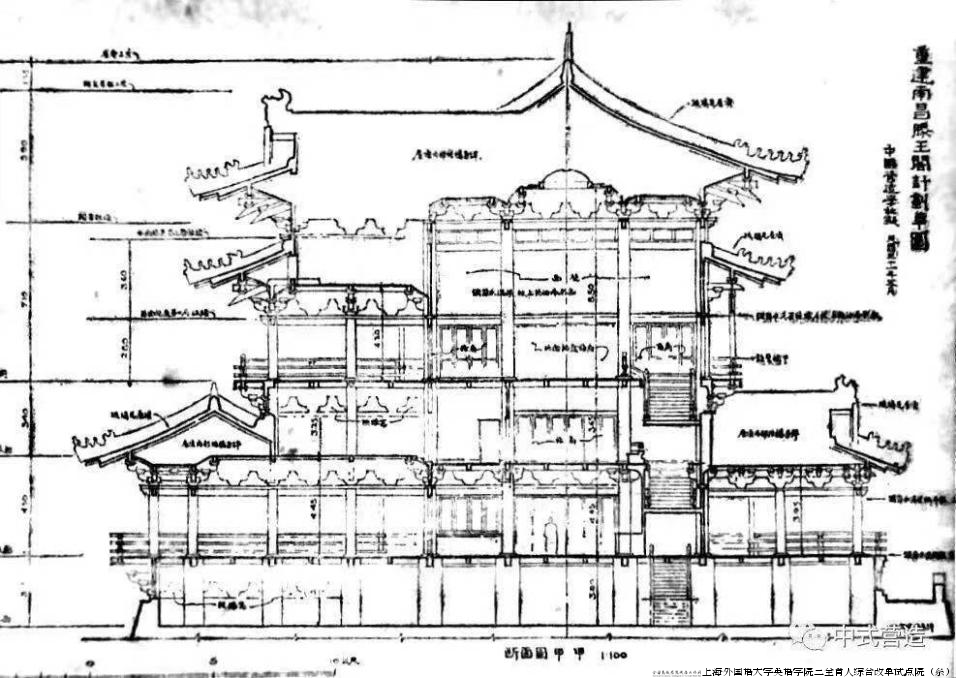赣方言区
赣方言是江西省的主要方言之一 ,主要使用区域为江西省的赣州、宜春、上饶、南昌等地。(The Gan Dialect is one of the dominant dialects of Jiangxi Province, mainly used in Ganzhou, Yichun, Shangrao, and Nanchang cities.) 赣语虽然内部百里不同音,但在音韵方面仍有不少彼此相通之处,各赣语方言大多拥有大量的文白异读、频繁的连音变调,并且皆无唇齿咬合发声的唇齿音。(Though Gan Dialect is so diverse that its accents vary even within every hundred miles, there are many similarities in phonology. For instance, in most dialects, the same word has different pronunciations in written and spoken contexts, and there are frequent connections and pitch fluctuations and no labiodental sounds.) 南昌位于江西省中部,是赣方言区的一颗璀璨明珠,孕育了无数令人向往的历史文化景观。

赣方言区分布图
(摘自《中国语言地图集》第二版)
本期“记忆的味道”将带领大家走进赣方言区——江西南昌,领略饱含古韵的建筑魅力,在现实中走近在语文教科书上早已见过的四大名楼之一——滕王阁。
滕王阁的前世今生
唐太宗李世民的第四子,李元婴,因在平定李自成叛乱中立下赫赫战功而被封为滕王。为了纪念父亲的恩德和自身的卓越贡献,唐永徽四年(公元653年),他决定在南昌修建一座宏伟的楼阁。
滕王阁的修建历时数年,其间历经波折,但最终在唐代中期建成。阁名“滕王”取自李元婴封号,而“阁”则象征高耸入云的楼阁式建筑。(Tengwang Pavilion was completed in the mid Tang Dynasty. The term “Pavilion” showcases the grandeur and height of the architecture, and its name derived from Li Yuanying, the Prince of Teng (known as Tengwang in Chinese), who commissioned its construction.)加上后世诗人王勃的一句“落霞与孤鹜齐飞,秋水共长天一色”滕王阁从此闻名于世。(A verse “Sunset glowing clouds and solitary ducks together fly; One are the autumn water and the sky on high” by Wang Bo, a prominent Tang poet, made Tengwang Pavilion renowned.)


现在,滕王阁已成为南昌的标志性建筑之一。(Nowadays, Tengwang Pavilion has become one of the iconic architectures of Nanchang city.) 这座千年古阁凝聚了南昌丰富的历史文化底蕴 (This ancient pavilion, boasting over 1,000 years of history, epitomes Nanchang’s profound historical and cultural heritage) ,吸引众多游客和文化爱好者前来参观,品味历史的厚重,感受古老时光的流转。滕王阁的建成不仅为南昌增添了一处靓丽的风景,更成为了当地文人雅士汇聚的场所,促进了南昌文化的繁荣与发展。(It is not only a striking landmark in Nanchang but a place for local intellectuals and scholars to gather and connect, promoting the cultural development and prosperity of Nanchang.)
滕王阁的建筑艺术
众所周知,中国古代建筑以木构架结构为主要的结构方式,木构架体系有抬梁式、穿斗式、井干式,而滕王阁属于抬梁式。 (As is known to all, Chinese classical architecture is dominated by wooden framework structures, including post and lintel structure, column and tie construction structure, and log cabin structure. Tengwang Pavilion belongs to the post and lintel structure.) 滕王阁的建筑是沿着房屋的进深方向在石础上立柱,柱上架梁,再在梁上重叠数层柱和梁,最上层梁上立脊瓜柱,构成一组木构架。抬梁式构架在春秋时已有,唐代发展成熟,一脉相承,形成一种独特风格,是中国建筑艺术中不可或缺的一部分。(The post and lintel structure is an indispensable part of Chinese architectural art.)
滕王阁屡建屡毁,屡毁屡建,历史上滕王阁重建了20余次。现存的滕王阁已经不再是传统的木制结构,而是用钢筋水泥建成。(Today, Tengwang Pavilion no longer features its original wooden structure; instead, it has been reconstructed using reinforced concrete.)
今人所建的滕王阁依据梁思成 (Liang Ssu-ch’eng) 的手稿,以宋代滕王阁 (Tengwang Pavilion in the Song Dynasty) 为蓝本,南北长80米,东西宽140米,高57.5米,占地13000平方米。
滕王阁还采用了回廊 (cloister)建筑形式,正脊鸱吻为仿宋特制,勾头、滴水均特制瓦当,勾头为“滕阁秋风”四字,而滴水为“孤鹜”图案。滕王阁的主阁又采取“明三暗七” (a “three plus four” structure, with three visible stories externally and an additional four internally hidden ones) 的结构,表面是三层带回廊建筑,实际却有七层,即三个明层,三个暗层,加屋顶的设备层,结构之精妙令人啧啧称赞。(Its exquisite structure enjoys people’s praise.)

梁思成滕王阁设计图纸
滕王阁的文化印记
千年风雨沧桑,滕王阁历经变迁,但文化的记忆却从未断绝。(The cultural memory embodied by Tengwang Pavilion never fades away.) 王勃的《滕王阁序》、汤显祖的《牡丹亭》等名人佳作让滕王阁从一座独特的建筑变为一个文化的符号。中华建筑文化的博大精深,在这座建筑中得以体现。(The Pavilion manifests the profound Chinese architectural culture.) 今天,我们再次登临滕王阁,在赣江之滨,万千思绪和无尽感慨,不仅是因为滕王阁的建筑之美,更是因为千年绵延的文化之盛。
参考文献:
[1]塔怀红.浅析江西滕王阁的建筑艺术[J].新西部(下半月),2009(11):133.
[2]滕王阁_百度百科
https://mbd.baidu.com/ma/s/MwLNFErv
[3]赣语_百度百科 (baidu.com)
[4]梁思成滕王阁设计图纸
https://m.sohu.com/a/436878135_755852?strategyid=00014
译文参考文献:
Excerpt from PREFACE TO TENG WANG GE(“KING OF TENG’S GRAND PAVILION”), by WANG BO (650-676), Translated by Frank C. Yue.
https://chinesepoetryinenglishverse.blogspot.com/, Accessed 6 Feb. 2024.
我要评论 (网友评论仅供其表达个人看法,并不表明本站同意其观点或证实其描述)
全部评论 ( 条)